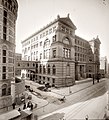Domingo Mora

Domingo Mora (1840–1911) was a Spanish-American sculptor and architectural sculptor.
Career
Born in Catalonia, Spain, he studied sculpture in Barcelona and Madrid. He emigrated to Montevideo, Uruguay, where he married French-born Laura Gaillard. They had two sons, both of whom became artists – F. Luis Mora (1874–1940) and Jo Mora (1876–1947). In 1877 the family moved to the United States, and Mora became chief designer for the Perth Amboy Terra Cotta Company. There, he designed architectural sculpture for hundreds of buildings, including New York City's Metropolitan Opera House.[1] He later settled in California.[2]
He was a member of the National Sculpture Society. Mora died in San Francisco, California, on July 24, 1911.[3]
Selected works
- Bas-relief panels on facade, Metropolitan Opera House, Broadway & 39th Street, New York City, J. Cleaveland Cady, architect (1882–83, demolished 1967).
- Reredos, All Saints Ashmont Episcopal Church, 209 Ashmont Street, Dorchester, Massachusetts, Ralph Adams Cram, architect (1892–93).[4]
- Rotch reredos, Emmanuel Episcopal Church, Boston, designed by Francis R. Allen, architect, 1904.
- Pedimental sculptures, New York Criminal Courts Building, Center & White Streets, New York City, Thom & Wilson, architects (1892–94, demolished ca.1939).
- 16 lifesize allegorical figures, Great Hall, Suffolk County Courthouse (now John Adams Courthouse), Pemberton Square, Boston, Massachusetts, George Albert Clough, architect (1893–94).[5]
- Architectural ornament, Tremont Temple, 88 Tremont Street, Boston, Massachusetts, Clarence Blackall, architect (1895–96).
- Architectural ornament, capitals and friezes on the George Walter Vincent Smith Art Museum, Springfield, Massachusetts (1895).
- Bas-relief panels on facade, Congregational House (now Congregational Library & Archives), 14 Beacon Street, Boston, Massachusetts, Shepley, Rutan and Coolidge, architects (1898).[6]
- Ceiling frieze of Music Room, J. P. Morgan Library, 225 Madison Avenue, New York City, McKim, Mead & White, architects (1907).
- Architectural sculpture, Newhall Building, 260 California Street, San Francisco, California, Lewis P. Hobart, architect (1908–10).
- Bas-relief panels on façade, Orpheum Theatre (now Palace Theatre), 620 S. Broadway, Los Angeles, California, G. Albert Lansburgh, architect (1911).[7]
-
 Metropolitan Opera House, New York City (1882–83, demolished 1967).
Metropolitan Opera House, New York City (1882–83, demolished 1967). -
 Pedimental sculptures, New York Criminal Courts Building, New York City (1894, demolished ca.1939).
Pedimental sculptures, New York Criminal Courts Building, New York City (1894, demolished ca.1939). -
 Tremont Temple interior, Boston, Massachusetts (1895–96).
Tremont Temple interior, Boston, Massachusetts (1895–96). - Terra-cotta entryway to the George Walter Vincent Smith Art Museum, in Springfield, Massachusetts (1895).[8]
-
 Congregational Library & Archives, Boston, Massachusetts (1898).
Congregational Library & Archives, Boston, Massachusetts (1898). - "Law" bas-relief panel, Congregational Library & Archives, Boston, Massachusetts (1898).
-
 "Troubador" bas-relief panel, Palace Theatre, Los Angeles, California (1911).
"Troubador" bas-relief panel, Palace Theatre, Los Angeles, California (1911).
References
- ^ Opitz, Glenn B., ‘’Mantle Fielding’s Dictionary of American Painters, Sculptors and Engravers’’, Apollo Books, Poughkeepsie, New York, 1988
- ^ Mitchell, Stephen, Jo Mora: Renaissance Man of the West. Stoecklein Publishing, Ketchum, Idaho, 1994, p.4
- ^ Kvaran & Lockley, A Guide to the Architectural Sculpture of the United States unpublished manuscript and website.
- ^ All Saints Ashmont. Archived January 9, 2013, at the Wayback Machine
- ^ The 16 caryatid figures are titled: Law, Temperance, Prudence, Justice, Fortitude, Punishment, Guilt, Equity, Right, Innocence, Reward, Wisdom, Religion, Virtue, Reason, and Legislation.
- ^ Congregational House Bas-reliefs from Boston Public Art.
- ^ Sandra A.B. Levis. "Broadway Historic Theater District: A walking tour sponsored by the Los Angeles Conservancy" (PDF). Los Angeles Conservancy.
- ^ A Souvenir of the Art Museum of the City Library Association. Springfield, Mass: Clark W. Bryan & Co. 1895.
Sources

- Oswald Spier, "Domingo Mora—A Sculptor in Clay," The Brickbuilder, An Architectural Monthly (Boston: Rogers & Manson, February 1912), pp. 28–32.[1]



![Terra-cotta entryway to the George Walter Vincent Smith Art Museum, in Springfield, Massachusetts (1895).[8]](http://upload.wikimedia.org/wikipedia/commons/thumb/2/26/George_Walter_Vincent_Smith_Art_Museum_-_Springfield%2C_MA_-_DSC03514.JPG/120px-George_Walter_Vincent_Smith_Art_Museum_-_Springfield%2C_MA_-_DSC03514.JPG)












